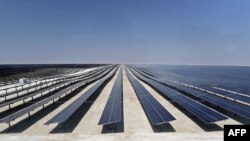Organizers have said Qatar will host the first "net zero" World Cup, but UAE Energy Minister Saad Sherida al-Kaabi said he could not confirm the plant will provide all the power for the football tournament.
Operational since June, the plant has a capacity of 800 megawatts and will "expand" further in coming years, al-Kaabi told a press conference.
It is planned to provide up to 10% of the Gulf nation's energy supply.
The solar farm in al-Kharsaah, west of the capital Doha, is "one of the biggest" in the Middle East, said al-Kaabi, also the president of QatarEnergy.
It was launched in 2016 in partnership with France's TotalEnergies and Japan's Marubeni as part of a broader push by Qatar — one of the world's biggest producers of liquified natural gas — to invest in solar energy.
With a cost of 1.7 billion Qatari riyals (about $467 million), the project consists of some 1.8 million solar panels and covers an area of more than 10 square kilometers.
Qatar, while lagging behind other Gulf states in the solar race, has announced a target of five gigawatts of solar energy capacity by 2035.
It announced two major solar projects in August that will more than double its energy output from the renewable source within two years.






